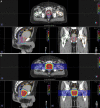Prostate Cancer Treatment with Pencil Beam Proton Therapy Using Rectal Spacers sans Endorectal Balloons
- PMID: 35774493
- PMCID: PMC9238133
- DOI: 10.14338/IJPT-21-00039
Prostate Cancer Treatment with Pencil Beam Proton Therapy Using Rectal Spacers sans Endorectal Balloons
Abstract
Purpose: Proton beam radiotherapy (PBT) has been used for the definitive treatment of localized prostate cancer with low rates of high-grade toxicity and excellent patient-reported quality-of-life metrics. Technological advances such as pencil beam scanning (PBS), Monte Carlo dose calculations, and polyethylene glycol gel rectal spacers have optimized prostate proton therapy. Here, we report the early clinical outcomes of patients treated for localized prostate cancer using modern PBS-PBT with hydrogel rectal spacing and fiducial tracking without the use of endorectal balloons.
Materials and methods: This is a single institutional review of consecutive patients treated with histologically confirmed localized prostate cancer. Prior to treatment, all patients underwent placement of fiducials into the prostate and insertion of a hydrogel rectal spacer. Patients were typically given a prescription dose of 7920 cGy at 180 cGy per fraction using a Monte Carlo dose calculation algorithm. Acute and late toxicity were evaluated using the Common Terminology Criteria for Adverse Events (CTCAE), version 5. Biochemical failure was defined using the Phoenix definition.
Results: From July 2018 to April 2020, 33 patients were treated (median age, 75 years). No severe acute toxicities were observed. The most common acute toxicity was urinary frequency. With a median follow-up of 18 months, there were no high-grade genitourinary late toxicities; however, one grade 3 gastrointestinal toxicity was observed. Late erectile dysfunction was common. One treatment failure was observed at 21 months in a patient treated for high-risk prostate cancer.
Conclusion: Early clinical outcomes of patients treated with PBS-PBT using Monte Carlo-based planning, fiducial placement, and rectal spacers sans endorectal balloons demonstrate minimal treatment-related toxicity with good oncologic outcomes. Rectal spacer stabilization without the use of endorectal balloons is feasible for the use of PBS-PBT.
Keywords: endorectal balloon; prostate cancer; proton therapy; radiation therapy; rectal spacer.
©Copyright 2022 The Author(s).
Conflict of interest statement
Conflicts of Interest: Sean P. Collins is a paid speaker for Augmenix. The authors have no additional relevant conflicts of interest to disclose.
Figures



Similar articles
-
Proton beam therapy delivered using pencil beam scanning vs. passive scattering/uniform scanning for localized prostate cancer: Comparative toxicity analysis of PCG 001-09.Clin Transl Radiat Oncol. 2019 Aug 31;19:80-86. doi: 10.1016/j.ctro.2019.08.006. eCollection 2019 Nov. Clin Transl Radiat Oncol. 2019. PMID: 31650043 Free PMC article.
-
Rectal Hydrogel Spacer Improves Late Gastrointestinal Toxicity Compared to Rectal Balloon Immobilization After Proton Beam Radiation Therapy for Localized Prostate Cancer: A Retrospective Observational Study.Int J Radiat Oncol Biol Phys. 2020 Nov 1;108(3):635-643. doi: 10.1016/j.ijrobp.2020.01.026. Epub 2020 Feb 6. Int J Radiat Oncol Biol Phys. 2020. PMID: 32035187
-
Dosimetric feasibility of moderately hypofractionated/dose escalated radiation therapy for localised prostate cancer with intensity-modulated proton beam therapy using simultaneous integrated boost (SIB-IMPT) and impact of hydrogel prostate-rectum spacer.Radiat Oncol. 2022 Apr 1;17(1):64. doi: 10.1186/s13014-022-02025-2. Radiat Oncol. 2022. PMID: 35365170 Free PMC article.
-
Polyethylene glycol-based hydrogel rectal spacers for prostate brachytherapy: a systematic review with a focus on technique.World J Urol. 2021 Jun;39(6):1769-1780. doi: 10.1007/s00345-020-03414-6. Epub 2020 Aug 25. World J Urol. 2021. PMID: 32840655 Free PMC article.
-
Rectal radiation dose-reduction techniques in prostate cancer: a focus on the rectal spacer.Future Oncol. 2018 Nov;14(26):2773-2788. doi: 10.2217/fon-2018-0286. Epub 2018 Jun 25. Future Oncol. 2018. PMID: 29939069 Review.
References
-
- Shipley WU, Tepper JE, Prout GR, Verhey LJ, Mendiondo OA, Goitein M, Koehler AM, Suit HD. Proton radiation as boost therapy for localized prostatic carcinoma. JAMA . 1979;241:1912–5. - PubMed
-
- Zietman AL, Bae K, Slater JD, Shipley WU, Efstathiou JA, Coen JJ, Bush DA, Lunt M, Spiegel DY, Skowronski R, Jabola BR, Rossi CJ. Randomized trial comparing conventional-dose with high-dose conformal radiation therapy in early-stage adenocarcinoma of the prostate: long-term results from proton radiation oncology group/American college of radiology 95-09. J Clin Oncol . 2010;28:1106–11. - PMC - PubMed
-
- Bryant C, Smith TL, Henderson RH, Hoppe BS, Mendenhall WM, Nichols RC, Morris CG, Williams CR, Su Z, Li Z, Lee D, Mendenhall NP. Five-year biochemical results, toxicity, and patient-reported quality of life after delivery of dose-escalated image guided proton therapy for prostate cancer. Int J Radiat Oncol Biol Phys . 2016;95:422–34. - PubMed
-
- Efstathiou J. Prostate advanced radiation technologies investigating quality of life (PARTIQoL) a phase III randomized clinical trial of proton therapy vs IMRT for low or intermediate risk prostate cancer. NCT01617161 Accessed. Oct, 2021. ClinicalTrials.gov.identifier https://clinicaltrials.gov/ct2/show/NCT01617161 .
-
- Kirk ML, Tang S, Zhai H, Vapiwala N, Deville C, James P, Bekelman JE, Christodouleas JP, Tochner Z, Both S. Comparison of prostate proton treatment planning technique, interfraction robustness, and analysis of single-field treatment feasibility. Pract Radiat Oncol . 2015;5:99–105. - PubMed
LinkOut - more resources
Full Text Sources
Miscellaneous
